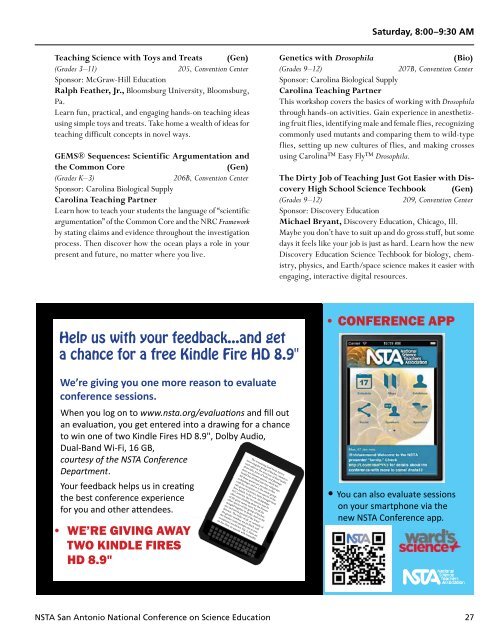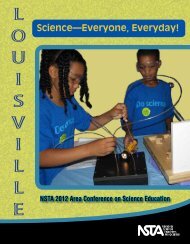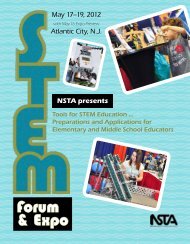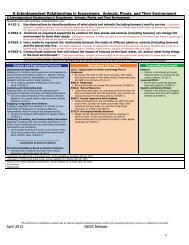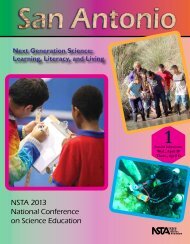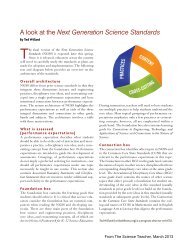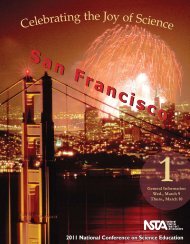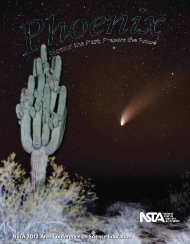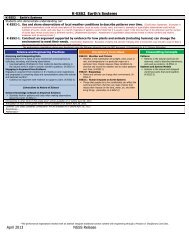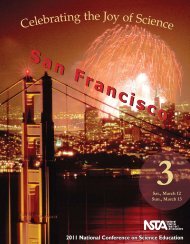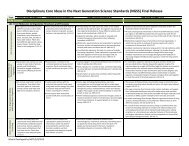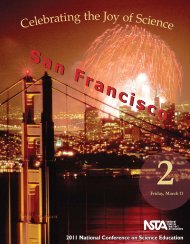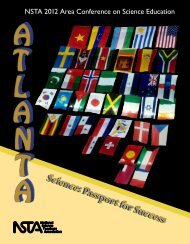NSTA 2013 National Conference on Science Education
NSTA 2013 National Conference on Science Education
NSTA 2013 National Conference on Science Education
Create successful ePaper yourself
Turn your PDF publications into a flip-book with our unique Google optimized e-Paper software.
Saturday, 8:00–9:30 AM<br />
Teaching <strong>Science</strong> with Toys and Treats (Gen)<br />
(Grades 3–11)<br />
205, C<strong>on</strong>venti<strong>on</strong> Center<br />
Sp<strong>on</strong>sor: McGraw-Hill Educati<strong>on</strong><br />
Ralph Feather, Jr., Bloomsburg University, Bloomsburg,<br />
Pa.<br />
Learn fun, practical, and engaging hands-<strong>on</strong> teaching ideas<br />
using simple toys and treats. Take home a wealth of ideas for<br />
teaching difficult c<strong>on</strong>cepts in novel ways.<br />
GEMS® Sequences: Scientific Argumentati<strong>on</strong> and<br />
the Comm<strong>on</strong> Core<br />
(Gen)<br />
(Grades K–3)<br />
206B, C<strong>on</strong>venti<strong>on</strong> Center<br />
Sp<strong>on</strong>sor: Carolina Biological Supply<br />
Carolina Teaching Partner<br />
Learn how to teach your students the language of “scientific<br />
argumentati<strong>on</strong>” of the Comm<strong>on</strong> Core and the NRC Framework<br />
by stating claims and evidence throughout the investigati<strong>on</strong><br />
process. Then discover how the ocean plays a role in your<br />
present and future, no matter where you live.<br />
Genetics with Drosophila<br />
(Bio)<br />
(Grades 9–12)<br />
207B, C<strong>on</strong>venti<strong>on</strong> Center<br />
Sp<strong>on</strong>sor: Carolina Biological Supply<br />
Carolina Teaching Partner<br />
This workshop covers the basics of working with Drosophila<br />
through hands-<strong>on</strong> activities. Gain experience in anesthetizing<br />
fruit flies, identifying male and female flies, recognizing<br />
comm<strong>on</strong>ly used mutants and comparing them to wild-type<br />
flies, setting up new cultures of flies, and making crosses<br />
using Carolina Easy Fly Drosophila.<br />
The Dirty Job of Teaching Just Got Easier with Discovery<br />
High School <strong>Science</strong> Techbook (Gen)<br />
(Grades 9–12)<br />
209, C<strong>on</strong>venti<strong>on</strong> Center<br />
Sp<strong>on</strong>sor: Discovery Educati<strong>on</strong><br />
Michael Bryant, Discovery Educati<strong>on</strong>, Chicago, Ill.<br />
Maybe you d<strong>on</strong>’t have to suit up and do gross stuff, but some<br />
days it feels like your job is just as hard. Learn how the new<br />
Discovery Educati<strong>on</strong> <strong>Science</strong> Techbook for biology, chemistry,<br />
physics, and Earth/space science makes it easier with<br />
engaging, interactive digital resources.<br />
Help us with your feedback...and get<br />
a chance for a free Kindle Fire HD 8.9"<br />
<br />
<br />
<br />
<br />
<br />
<br />
<br />
<br />
<br />
<br />
<br />
<br />
<br />
<br />
The remaining land-birds form a<br />
most singular group of finches, related to<br />
each other in the structure of their beaks,<br />
short tails, form of body and plumage:<br />
there are thirteen species, which Mr.<br />
Gould has divided into four subgroups.<br />
All these species are peculiar to this<br />
archipelago; and so is the whole group,<br />
with the excepti<strong>on</strong> of <strong>on</strong>e species of the<br />
sub-group Cactornis, lately brought from<br />
Bow Island, in the Low Archipelago.<br />
Of Cactornis, the two species may be<br />
often seen climbing about the flowers<br />
of the great cactus-trees; but all the<br />
other species of this group of finches,<br />
mingled together in flocks, feed <strong>on</strong> the<br />
dry and sterile ground of the lower<br />
districts. The males of all, or certainly of<br />
the greater number, are jet black; and<br />
the females (with perhaps <strong>on</strong>e or two<br />
excepti<strong>on</strong>s) are brown. Fig. 2, there are<br />
no less than six species with insensibly<br />
<br />
<br />
<br />
<br />
<str<strong>on</strong>g>NSTA</str<strong>on</strong>g> San Ant<strong>on</strong>io <str<strong>on</strong>g>Nati<strong>on</strong>al</str<strong>on</strong>g> <str<strong>on</strong>g>C<strong>on</strong>ference</str<strong>on</strong>g> <strong>on</strong> <strong>Science</strong> Educati<strong>on</strong><br />
27


